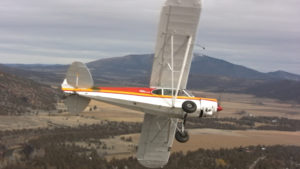The Tailwheeler’s Journal #10
“The Cowboy Way”
The country music group, “Riders in the Sky” has a running gag. When one of them points out that something “might be the easy way…”, knowledgeable audience members call out in unison, “but it wouldn’t be THE COWBOY way!”
We who fly are constantly faced with a similar choice. We can do our landing approaches the easy way (stabilized approaches, big patterns, gradual flap application) with no challenge to our flying skills and thus no improvement in them OR we can do them the CHALLENGING way (swooping short approaches with power off accuracy and all the flaps at once on short final) with an attendant increases in our skills.
Many general aviation pilots will question my attitude toward their methods: “Why do you think airliners fly stabilized approaches? They assure proper speed, configuration and accuracy at the bottom of the approach. All that hooey you preach is fine for your little planes but there’s a solid reason for the wide pattern, gradual flap application and stabilized approach”.
I think such a challenge makes my case. Are you flying a 767? Well -trained DC3 pilots flew the swooping approach into Berlin during the Airlift. C-130 pilots used it into Saigon during the Vietnam War. I’m addressing single engine pilots, for whom the swooping, dynamic approach should be a piece of cake… if they practice.
Flap usage is a major part of this subject. I’m working with a respected colleague on a future issue of the Journal that will address this controversial subject. You’ll see it soon.
How does safety enter into the equation? The quest for increased pilot skills need not compromise safety. Start with gradually shrinking your pattern size. If you’ve always flown big patterns and stabilized approaches and would like to learn to be more competent, just take it bit by bit. Set up some parameters that are reasonable. Start practicing some power-off overhead approaches. Practice descending steep turns at altitude, then start gradually moving your pattern in closer so that eventually you can fly a downwind-to-final turn with minimal distance on final. Don’t try to do it all at once. In the end you’ll be a more competent, safer airman.
Don’t confuse perception with reality. I fly out of a resort airport. In the resort business we learn that perception is often treated as more important than reality. Unfortunately that often applies to flying as well. I know some pilots who are considered really safe by others. That perception is the result of their cautious methods, including shallow banked turns, long gradual approaches and professional-sounding radio usage. Some of them are ticking time bombs. The “cautious” pilot will be hard-pressed to fly his way
out of a tough situation caused by traffic, weather or mechanical failure. He simply hasn’t enough practice. That’s reality, not perception.
Other people who fly airplanes will see us practicing these more difficult approaches and other maneuvers. They will often call us “Cowboys” (what a coincidence, huh?). That’s okay. When the chips are down and a high degree of piloting skill is required, I’d rather be with the guy who can do it “the cowboy way”.
Happy Swooping!
Brian


